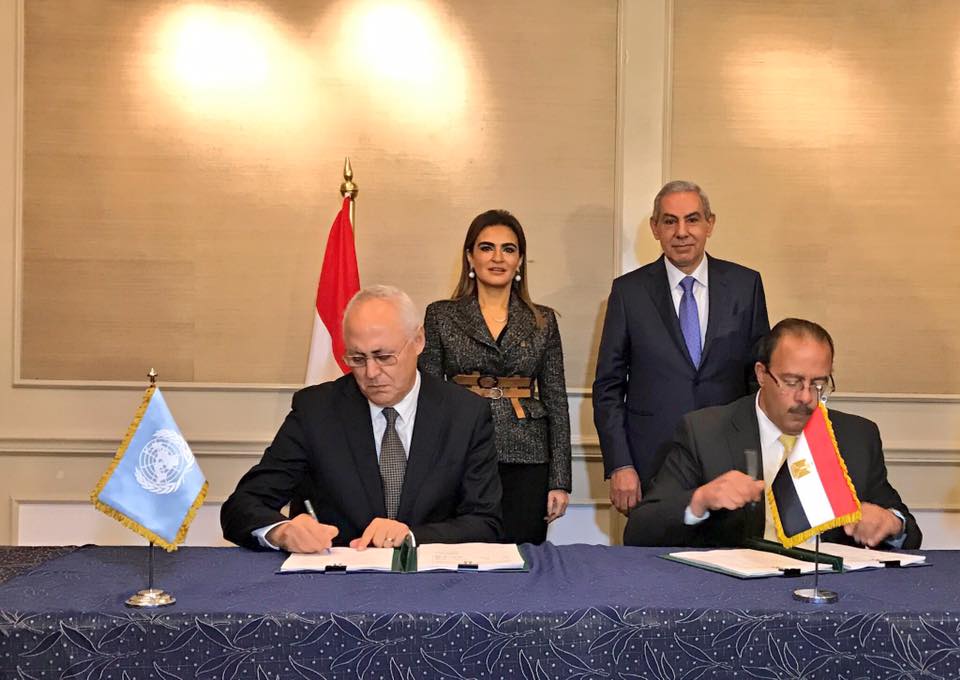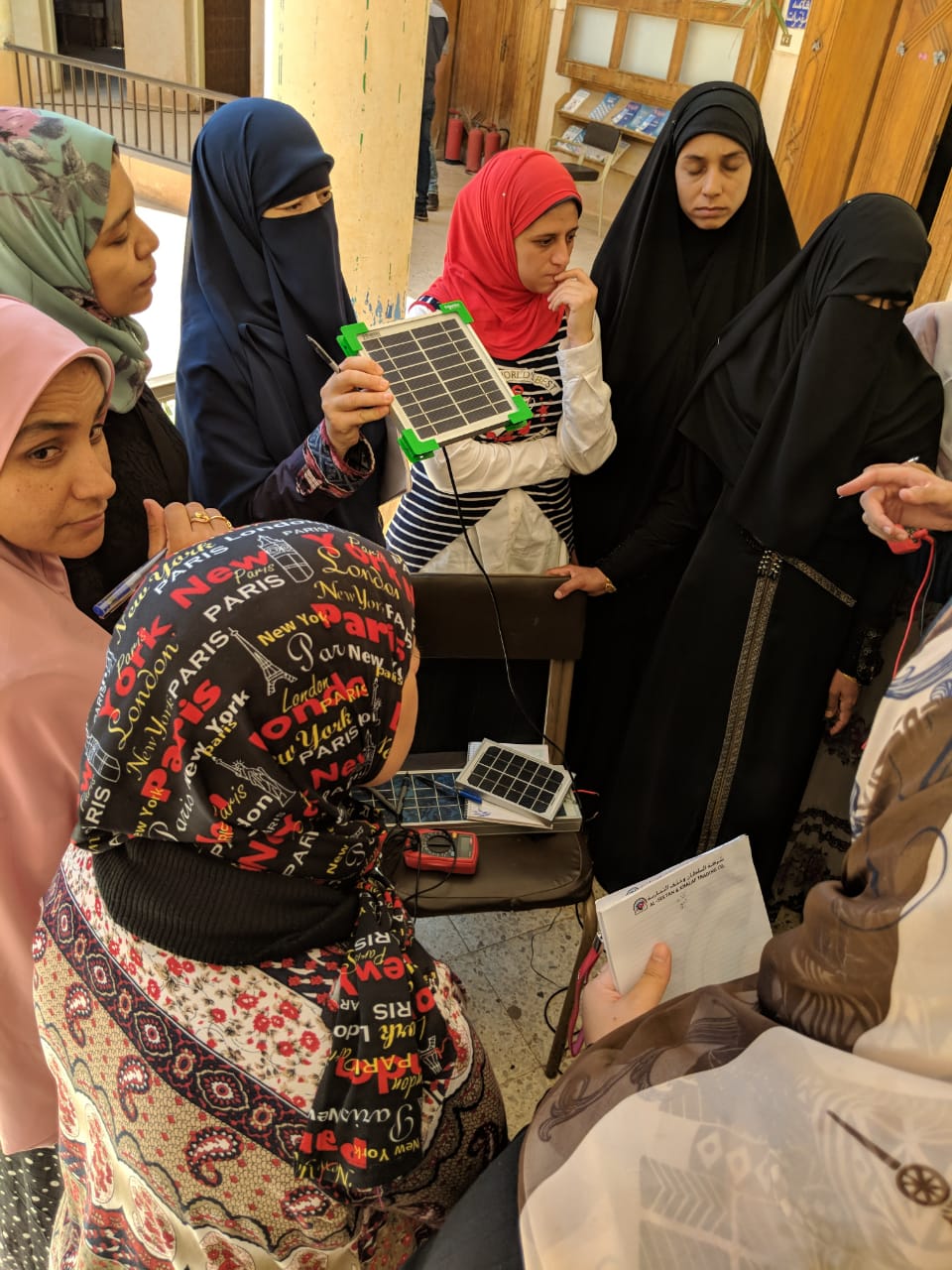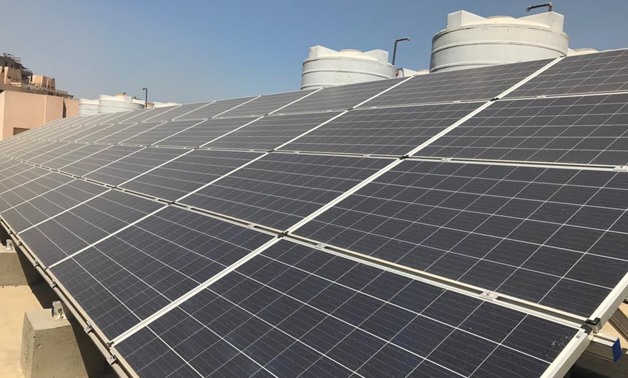A shift to green technology is taking Egypt by a storm amid growing trends to employ clean energy and a national agenda prioritizing sustainable development. The ambitious move has required an equally ambitious initiative with the aim to over- come every barrier in the market, be it technical, financial or linked to local manufacturing or capability building.
Launched in 2017 by the United Nations Development Program (UNDP) in cooperation with the Industrial Modernization Center (IMC), the Grid-Connected Small-Scale Photovoltaic Systems project, known as Egypt PV, is funded by the Global Environment Facility (GEF).
“The project aims to remove the barriers to in- crease power generation by small, decentralized, grid-connected PV [photovoltaic] systems implemented by households and small- and medium- size enterprises,” as stated on the project’s official website. “The target is to facilitate the installation of at least 4 MWp of new decentralized private PV capacity during the lifetime of the project.” The project already achieved double its targets by in- stalling 8.5 MW in 2 years.
Egypt PV seeks to open markets for small-scale PV systems, which are solar plants with a capacity below 500kW and a life span of 25 years.
Business Today Egypt sat down with Dr. Hend Farouh, the national project manager, to learn more about the project and how it has tackled technical and non-technical barriers to advance solar projects in Egypt.
.JPG)
Dr. Hend Farouh, the national project manager of the Grid-Connected Small-Scale Photovoltaic Systems project at the UNDP - Photo taken by Nourhan Magdi/Egypt Today
bt: How did Egypt-PV set a standards criterion for solar projects?
Farouh: We set technical standards and specializations, which are available on our website, to guarantee the quality and efficiency of any installed PV panel, so that anyone who wants to install a solar plant would ask the company hired to implement these
specializations.
We also put together a set of criteria; one of them is that the company should be registered with the New and Renewable Energy Authority, and have installed at least 100KW of solar panels. Companies should also guarantee three years of full efficiency of each solar plant, seven years of efficient current transformer, and 15 years for the panels. Companies should also train their workers on maintenance of the panels. There should also be a clear exit strategy.
Upon these criteria, we chose 51 companies to serve people by installing solar systems as part of the Small-Scale Photovoltaic Project.
Egypt PV is not a funding mechanism, but rather a catalyst to encourage the market and individuals to invest in solar energy. The project provides non-refundable financial assistance be- tween $200-$250 per kilowatt. With the prices of solar panels decreasing, we aim to solely provide technical support in the future without financial support.
bt: Tell us more about the technical support you provide.
Farouh: We first study the site and estimate the cost of the solar plant, with both an initial feasibility study and a technical study. A payback period is now ranging from three to four years, which is a plus after the period had been longer in the past, reaching up to 10 years.
We also prepared a booklet of standards matching the site assessment, and a list of companies with various offers, [through which] we can also help customers to evaluate the offers and choose the best that suits them.
Further, we take part in the installing phase, and follow-up after the operation; we also visit the site to examine the efficiency of the installed solar plant, as well as all the project’s expenses.
Regarding the sustainability of the solar plants, one important thing is that we visit the site a year after the operation to draft a quarterly report based on our simulation of production and efficiency.
A maintenance manual, upon which we trained workers on maintenance, follow-up and operation, was on our agenda too.

From Left to Right: UNDP Resident Representative a.i. El-Mostafa Benlamlih, IMC Executive Director Eng. Ahmed Taha Boraie and witnessed by The ceremony has been witnessed by Minister of International Cooperation Sahr Nasr and Minister of Industry and Trade Engineer Tarek Qabil. UNDP Egypt/Fatma Elzahraa Yassin
bt: How is Egypt-PV raising public awareness about solar energy?
Farouh: For people to digest the project’s idea and realize the importance of installing solar panels on environmental and investment levels, they need to see real projects.
That’s why we prepared 136 indicative models for 96 solar projects in total, to showcase our projects and their implementation in different facilities: hospitals, hotels and public buildings. A total of 63 projects are completely installed and connected to the national grid. The rest of the projects should be finalized by the end of December 2019.
People have started to see the projects coming to life around them, at places they usually visit like big shopping malls, petrol stations, residential compounds and hotels.
Other bids include installing screens at every project showing the current solar production and the total amount generated since the installation, as well as the amount of carbon dioxide reduced, in a way to indirectly raise awareness among the public. We can also monitor the efficiency of the plants internally, a move that has raised the efficiency of all projects; and that’s what we look for. The projects’ owners can also remotely monitor the production and efficiency of the plant through their phones.
We developed a non-technical user’s guide that simply explains everything [about] solar energy to ordinary citizens who have no background about the sector, answering all possible questions about different aspects like on-grid and off-grid solar systems and battery-powered systems.
bt: You talked about training services, how many engineers have you trained?
Farouh: We are working on different levels: technical barriers, financial barriers and funding issues, building human capabilities; [we have] trained around 200 engineers on maintenance, installation and operation procedures. The project reached out to engineers in remote areas, like EL Wadi El Gadid governorate.
Before the project, we had carried out a market study and held workshops with all
concerned bodies and stakeholders to understand the obstacles facing solar projects. Unfortunately, we can rarely find technicians specialized in installing solar panels. Benban school for technicians recently inaugurated to serve the major Benban solar project.

Training at Engineering Syndicate in Wadi Gadid - Photo courtesy of UNDP office in Cairo
bt: What is the minimum and maximum distance of a solar plant in the project?
Farouh:The minimum length of the plant is 5 kilowatts as set by the Ministry of Electricity, and the project was initially designed to support up to 500 kilowatts, but whenever we encounter projects larger than this, we still provide them with technical support until we have more service providers and advisors.
bt: Who do you advise to install solar systems?
Farouh: People whose electricity bill is above 650 kW are highly encouraged to think in energy shifting.
This is because the amount of money saved on their electricity bills will be dramatic, taking into consideration the initial cost, bill difference, and payback period based on studies.
How can a solar system be installed on a shared rooftop of residential buildings?
Farouh: The cost of solar systems is still deemed expensive for ordinary citizens, so for the residents of a 24-apartment building to have a solar plant, they will need to share in order to install a solar system of 10kW on the rooftop of the building, which is worth L.E.150,000. Each apartment will pay around L.E.6,250 once. The electricity generated from the plant will feed the elevator, the stairs’ illumination and the lighting system around the building and water pumps. Based on our figures, such plants can reduce the cost of regular maintenances of the building by 50% to 70%.
How can citizens determine the solar plant’s capacity to install based on their consumption?
Farouh: We have introduced a new service on our website, an online calculator to help citizens and companies know the area needed for the installed PV system, the system cost, the payback period, the discount rate and the energy produced by the system per year, which varies between 1600 and 1800kW per year depending on the timing of the year and the location.
How can citizens use the online calculator?
Farouh: Citizens input their residential area and governorate, and the distance of the solar plant they want to install based on the knowledge that 1kW of solar panels needs around 10-12 km2 of un-shaded space. According to the data logged in, the website provides the internal rate of return (IRR) and the initial cost, which is updated based on the modification of tariff prices by the government.
What are the sectors that see high demand of solar systems’ installation?
Farouh: There is a huge demand on installing solar systems by the industrial sector and the hotels. We also installed PV panels atop of governmental buildings, like a project at the General Authority for Educational Buildings. One of the main reasons for such a turnout is that multinational institutions and companies are shifting to green maintenance and technology in accordance with the country’s implementation of the sustainable development agenda. Such companies seek to reduce their CO2 emissions.
The solar system sector has witnessed strong momentum, with the price of solar panels decreasing as they coincide with the government’s subsidy cuts leading to increases in electricity prices.
How can the media play an effective role in publicizing such projects?
Farouh: We believe in the media’s role and the change it can make by transmitting information and knowledge about the solar systems, because we will not be able to talk to everyone. That’s why the user’s guide we put together will be distributed among journalists as well, not only citizens.



Comments
Leave a Comment